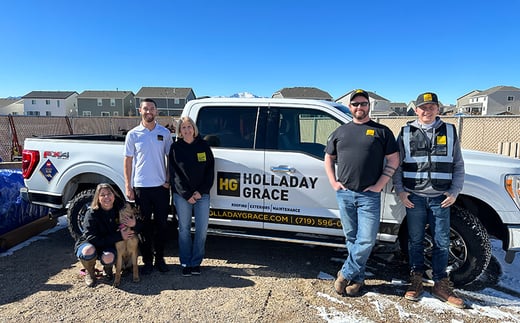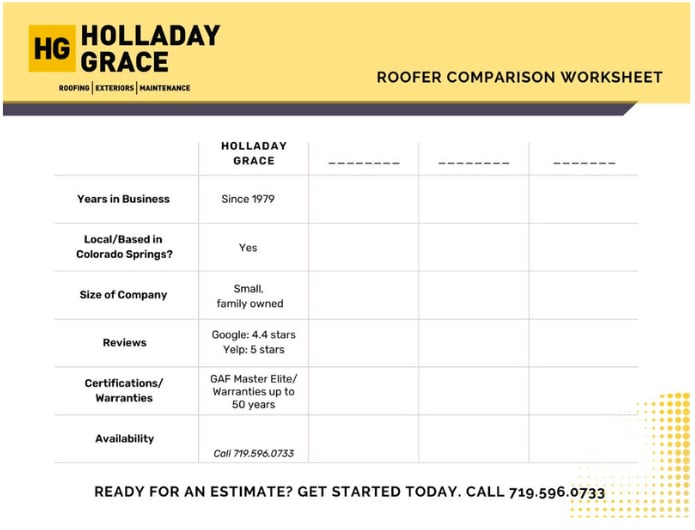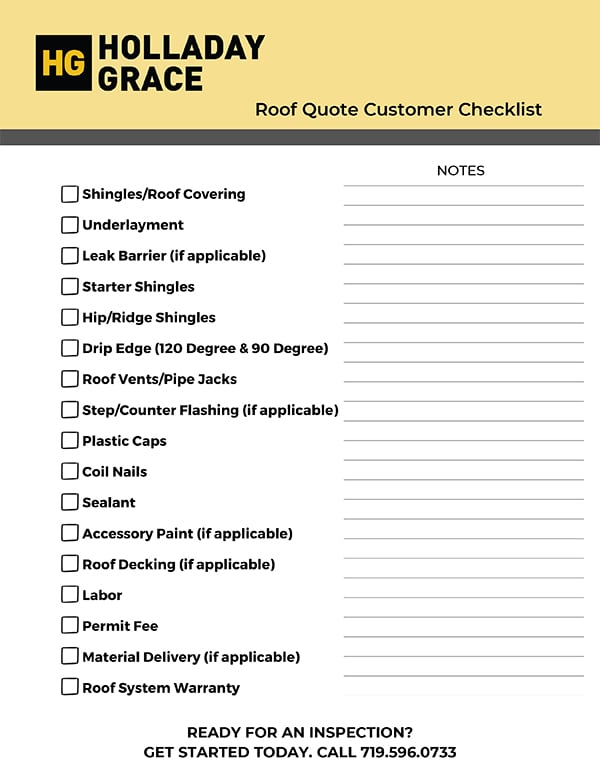THE HOMEOWNER'S GUIDE TO BUYING A ROOF REPLACEMENT
- Chapter I: INTRODUCTION
- Chapter 1: 5 SIGNS YOU NEED A ROOF REPLACEMENT
- Chapter 2: ABOUT YOUR ROOF TERMS & COMPONENTS
- Chapter 3: CHOOSING THE RIGHT ROOFING MATERIAL
- Chapter 4: HOW MUCH DOES A NEW ROOF COST?
- Chapter 5: FINANCING YOUR NEW ROOF
- Chapter 6: WARRANTIES ON YOUR NEW ROOF
- Chapter 7: FINDING A QUALIFIED ROOFING CONTRACTOR
- Chapter 8: GETTING AN ESTIMATE FROM HOLLADAY GRACE
- Chapter 9: CONCLUSION
INTRODUCTION
Buying a new roof can be very daunting, not only because of the cost but also because of the many
factors in the buying process. Whether you've endured a severe weather event, found a leak, or are at the end of your roof's lifecycle, it's not uncommon to find yourself feeling overwhelmed and asking questions like:
- How much is this going to cost me?
- What types of roofing materials are best for my home?
- How do I find a reputable contractor and avoid being taken advantage of?
- Where do I start?
- How can I be sure I'm making the right decisions?
If you feel like you have so many questions and no one to answer them, fear not. With 43 years of experience in the roofing industry, Holladay Grace has created this guide to help you make the best purchasing decision for your home.
5 SIGNS YOU NEED A ROOF REPLACEMENT
It can be hard to know if you have a roof that can be repaired or if you need a full replacement. You may have noticed some signs of wear and tear on your roof due to age, or maybe your roof was just hit with a major wind or hail storm. We are here to help take the guesswork out of your need for a roof replacement. Read on to learn about the 5 signs you may need a repair or full roof replacement.
Sign 1 - Leaks
Leaks are often caused by damaged roof seals or damaged shingles. Leaks can be very obvious (with water coming into your home) or not obvious at all. Your roof might be leaking, and you don’t even know it. Water can slowly seep into your decking or insulation and may not show for a long time. By the time you notice a leak, the damage done may be more extensive than what you can see.
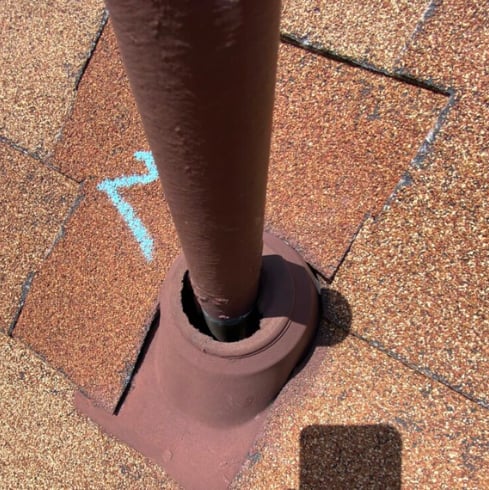
Sign 2 - Interior Water Damage
Interior water damage caused by a roof leak looks different than damage caused by pipe leaks. Determining whether the internal water damage is from your roof can be relatively simple. Water damage from a roof leak most often occurs at the lowest point of your roof. The lowest point is often in a valley at the eave of your roof.
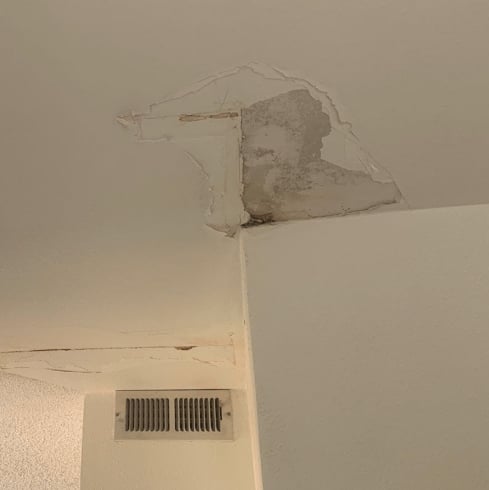
Sign 3 - Damaged Shingles
Damaged shingles can be a sign that you may need a roof replacement. Shingle damage can manifest itself in several ways, including:
- Granular Loss
- Blistering of the Shingles
- Unsealed Shingles
- Flaking
- Batch Problems / Manufacturing Issues
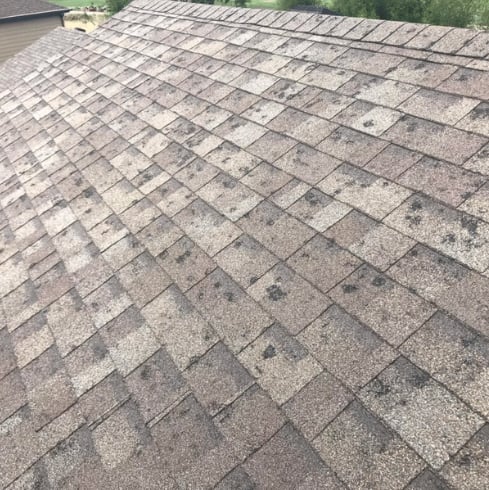
Damaged Shingles - Granular Loss
Some granular loss is expected with new roofs because of how shingles are manufactured. A portion of the granules on asphalt shingles are not actually attached to the asphalt of the shingles, so some granular loss when the roof is first installed is normal. The loose granules will work themselves out of the shingles and wash into your gutters and down your downspouts. However, what is out of the ordinary is when you start to see excess granular loss on an older roof. Granular loss on older roofs could mean that your shingles are deteriorating and may need to be replaced.
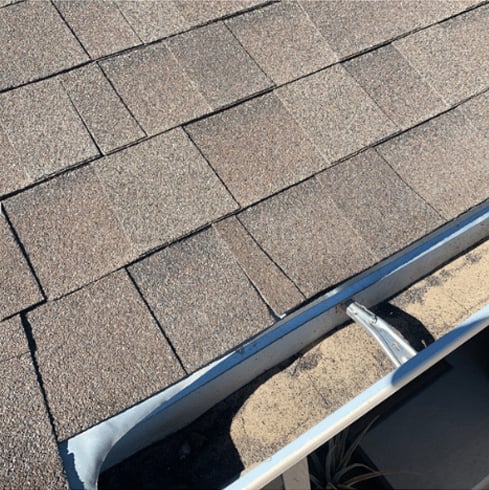
Damaged Shingles - Shingle Blistering
Roof blistering occurs when there is trapped moisture or air beneath the layers of roofing or within the shingles themselves. As the temperature outdoors continues to rise, the pressure in these patches forces the air or moisture to expand. The asphalt will begin to weaken, forming a blister on the surface of the roofing shingle. Roof blistering can also occur from poorly ventilated roofs. If the roof is not ventilated appropriately, the heat can be too intense for the shingles and lead to blistering.
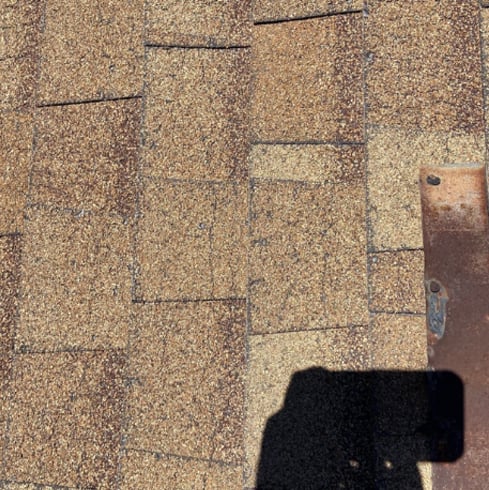
Damaged Shingles - Unsealed Shingles
The bottom edge of all asphalt shingles have an asphaltic adhesive strip that seals the shingle to its adjacent shingles. As the sun heats up the shingle after it is installed, that adhesive strip heats up and bonds each shingle together to keep the shingle from flapping in windy conditions. However, as that adhesive strip deteriorates over time, the shingles can lift and become unsealed.
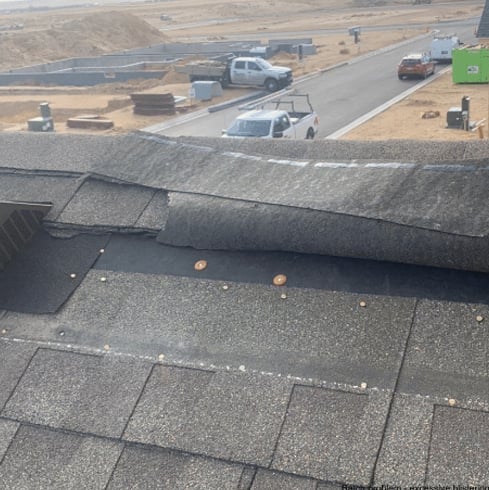
Damaged Shingles - Flaking
Flaking is a term often used to describe localized shingle delamination. This localized delamination can either be caused by impurities in the asphalt coating or even anomalies or issues with the manufacturing process that creates weak points in the shingles themselves. If left unchecked, this flaking can severely damage the integrity of your roofing system.
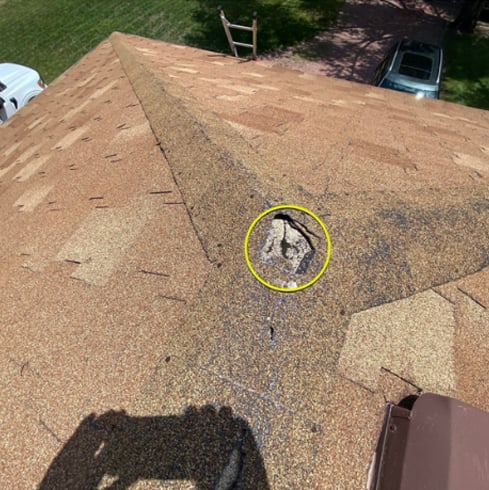
Damaged Shingles - Batch Problems
When shingles are produced, occasionally, there are issues with the batch that quality control may not catch before the bundle of shingles is delivered to the supplier and, ultimately, the customer. Batch problems that can compromise the shingles and cause them to need replacing can include all of the above-stated issues but most often have excessive granule loss or excessive blistering of the shingles.

Sign 4 - Compromised Roof Line
When you get a new roof installed, your roofline should be straight and square to each other and the house. When your roofline starts to bow and sag, it is time to investigate what is going on. A compromised roofline could be an indication that you need to look into replacing your roof. Some causes of a compromised or sagging roofline include poor ventilation, roof installation when either the decking or underlayment was wet, or rotting decking.
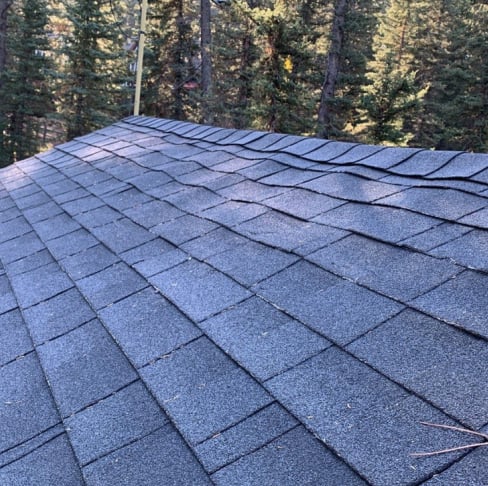
Sign 5 - Weather Damage
Weather damage occurs after severe weather events like a heavy wind or hail storm. Damaged shingles from a previous weather event leaves you more susceptible to weather damage moving forward. For example, wind-damaged shingles that are cracked or torn will be more likely to fail and cause leaks or damage to your underlayment. That damage to your underlayment can compromise your entire roofing system over time and could cost a great deal of money to repair if left unattended.
In the following pages, we discuss the 3 most common roof-damaging weather in Colorado Springs, CO.
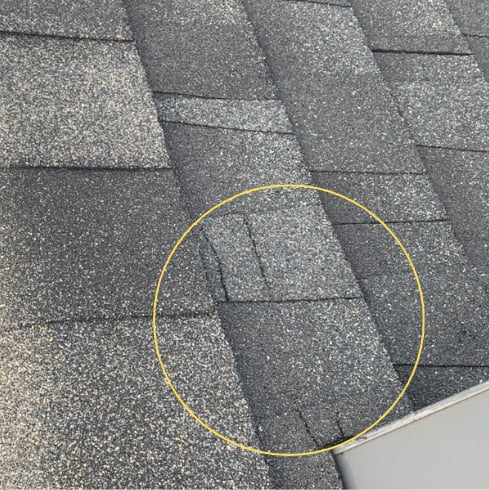
Weather Damage - Hail
Hail damage can be difficult to spot but can be a big problem. Hail damage often looks like a divot in the shingle and can leave some areas bare where granules were knocked off the shingle. While no raised area around the divot may exist, the shingle itself will have granule loss and may be dented at the actual impact area. These dented areas will fail, causing leaks and even interior water damage to your home.
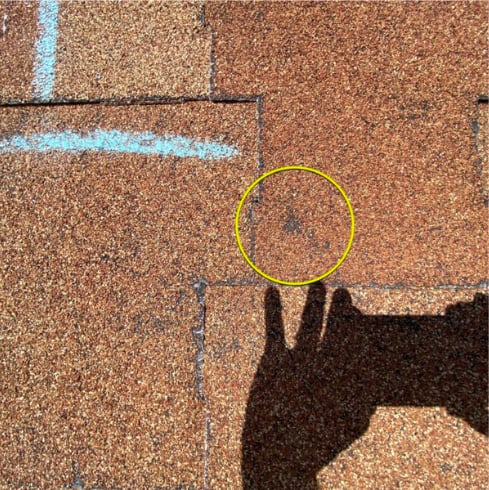
Weather Damage - Wind
Wind damage occurs when wind gets underneath the shingle. Even if the shingle is not fully blown off from the wind, damage to your shingles can still occur. What will usually happen is the wind will catch the underside of the shingle and bend it back, creating a crack that will ultimately result in a weak spot in the shingle. If subjected to further wind while unsealed, the shingle will ultimately tear off. Additionally, keep in mind that when wind goes over your roof, it can double in speed as it goes up and over the ridge of your home. For example, if the weather report shows 30 mph winds, your roof could have sustained 60 mph as the wind went over your home.
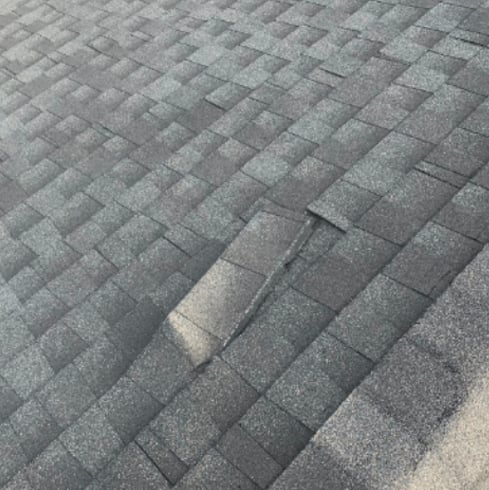
Weather Damage - Falling Debris
Falling debris can be a big issue for your roof, depending on where you live. Areas that see large amounts of heavy wind can experience dislodged tree limbs that can damage your roofing system. Falling debris can damage the shingles on your roof and even the decking and possibly the roof trusses if the debris is large enough.
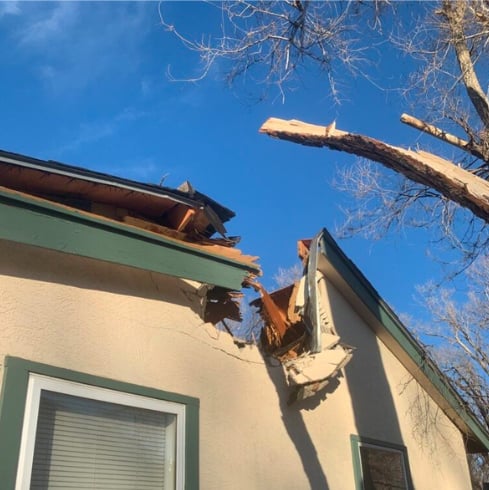
About Your Roof terms & Components
Terms
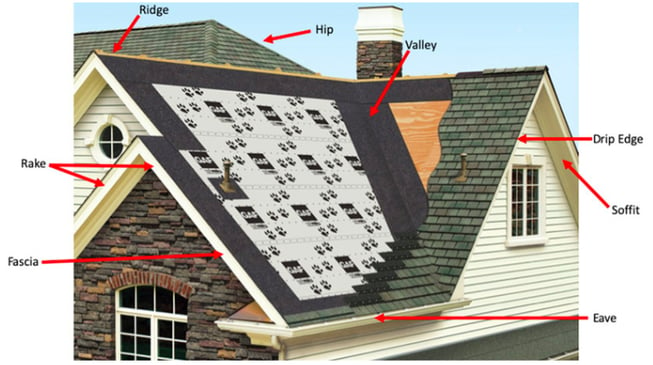 Ridge: The highest point on a roof where two roof areas intersect.
Ridge: The highest point on a roof where two roof areas intersect.
Hip: Where two roof areas intersect, which are not the ridge nor the valley.
Valley: The part of a roof where two roof slopes intersect.
Drip Edge: The edge of the roof.
Soffit: The underside of a roof eave, it connects the fascia to the side of the house.
Eave: The edge of a roof that overhangs a wall.
Fascia: The long board that runs along the edge of a roof, often behind the gutter.
Rake: A non-guttered roof edge.
Components
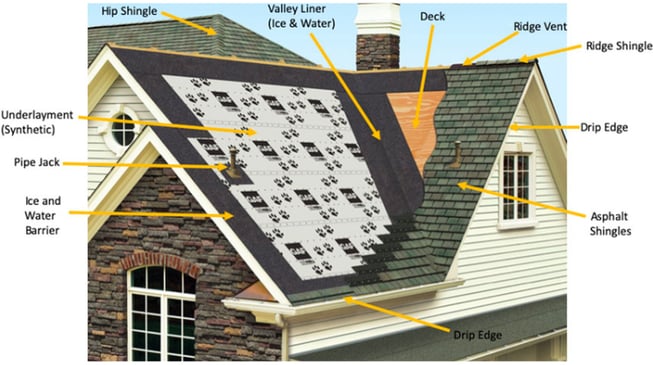 Hip Shingle: The top course of shingles that provide a protective bridge between two slopes along a hip edge of a roof ensuring it’s weathertight between the slopes.
Hip Shingle: The top course of shingles that provide a protective bridge between two slopes along a hip edge of a roof ensuring it’s weathertight between the slopes.
Valley Liner (Ice & Water): Metal flashing or ice and water barrier installed to protect the vulnerable valley of a roof and divert water off the roof.
Deck: The boards or sheet material fastened to the roof rafters or truss on which the roof system is laid. Also called sheathing.
Ridge Vent: A type of continuous vent along the ridge of a sloped roof designed to allow for the passage of warm air and humidity out of the attic.
Ridge Shingle: The top course of shingles that provide a protective bridge between two slopes along the ridgeline of a roof, ensuring it’s weathertight.
Drip Edge: A metal flashing; installed at the edges of the roof to help control the flow of water away from the home.
Asphalt Shingles: The most common roof covering in North America, designed to be a cost-effective barrier to water. Asphalt Shingles come in three types: 3-Tab, Architectural, and Designer.
Ice & Water Barrier: A self-adhering membrane designed to help prevent leaks due to water backing up in your gutters, wind-driven rain, and ice dams.
Pipe Jack: A galvanized steel and rubber boot that seals around the pipe and creates a watertight barrier
Underlayment (Synthetic): A water-resistant barrier installed directly onto the roof deck. The most common underlayment is felt (or felt paper), either synthetic or asphalt-based.
Choosing the right roofing material
Asphalt Shingles
Asphalt shingle roofs are the most common roofing material that you will encounter on homes today. You do have some additional choices when it comes to asphalt shingles, as there are two main types installed today: dimensional and designer shingles. While some older roofs do have 3-tab shingles, you will more commonly see dimensional shingles installed on new roofs. Designer shingles may not be as popular as dimension shingles, but they are still seen all over Colorado Springs. The main difference between the two, aside from the look, is that designer shingles are typically more expensive due to the higher manufacturing cost. Typically, designer shingles hold up slightly better to hail in Colorado Springs as well.
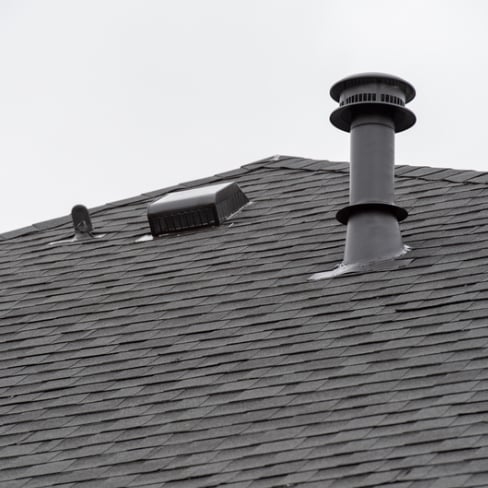
Asphalt Shingles - Solar Shingles
Solar shingles are relatively new to the industry and are becoming more and more common in Colorado Springs. Solar shingles differ from rack-mounted solar panels as the shingles seamlessly integrate into the asphalt roofing system. Solar shingles are fastened directly over the underlayment and roof deck. They provide a low-profile look and have many benefits that homeowners prefer over traditional rack-mounted solar systems. Additionally, roofers install solar shingles, meaning the same crew installing your roof will install the solar shingles.
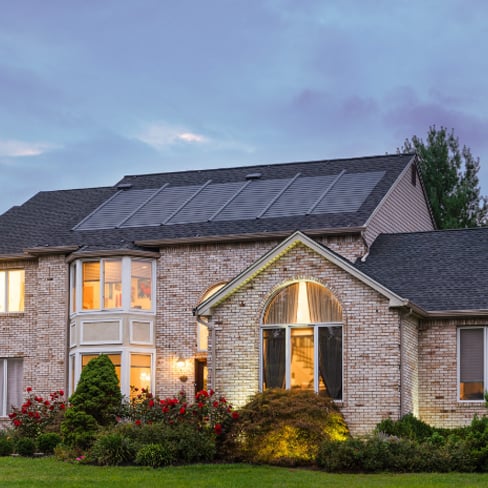
Asphalt Shingles - Dimensional
The most common roof covering in North America. Dimensional shingles, also known as "architectural" shingles, have two layers of shingle material that are bonded together with sections of the top layer taken out. This layering to done to add depth and make the shingle look more like wood, slate, or shake shingles.
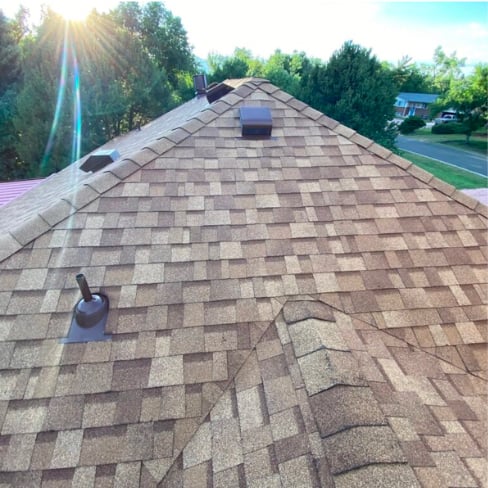
Asphalt Shingles - Designer
Designer asphalt shingles are a more "premium" offering of asphalt shingles. With a more premium look, the curb appeal for designer shingles is much higher over standard dimensional shingles.
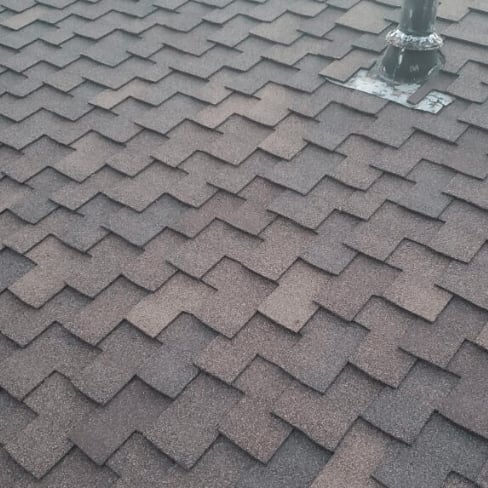
Standing Seam Metal
Standing seam metal roof systems consist of metal panels that lock together or are mechanically fastened together at the seams. Being fastened at the seams allows the roofing material to expand and contract with changes in temperature. Standing seam metal roofs are not as common on residential roofs primarily because they are expensive. However, standing seam metal roofs are becoming more popular due to the aesthetic look they provide. Metal roofs perform very well in various weather conditions, however, they are prone to dents in hail storms, and sometimes insurance policies exclude cosmetic damage, so metal roofs can be more difficult to get replaced in insurance claim projects.

Synthetic Shingles
Synthetic shingles are newer to the market compared to asphalt shingles. Synthetic shingles are a more sustainable alternative to older roofing solutions like cedar shake and slate roofs. Synthetic shingles primarily replace cedar shake and slate roofing systems. These shingles are made of either recycled materials or an engineered polymer, and are injected into molds of actual cedar shake and slate tiles. Synthetic tiles look quite similar to their real counterparts, but compared to dimensional asphalt shingles, their price is conservatively double. Synthetic shingles are also a better alternative to cedar and slate because of their increased durability and longer life.
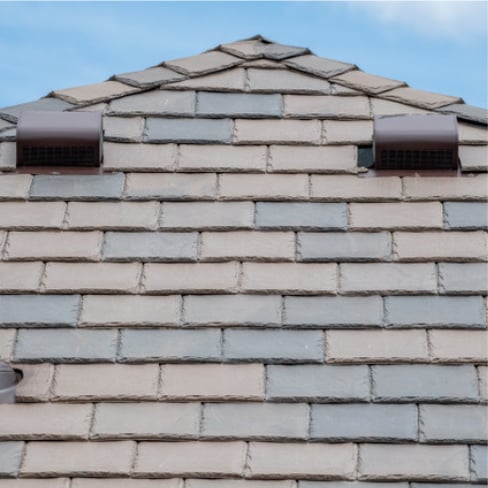
DaVinci Shake Synthetic Roof
DaVinci Single-Width Shake tiles are made to imitate authentic cedar shake tiles. This is achieved by taking molds of real cedar shake tiles, making them a perfect replacement for projects where a cedar shake look is either required or preferred.
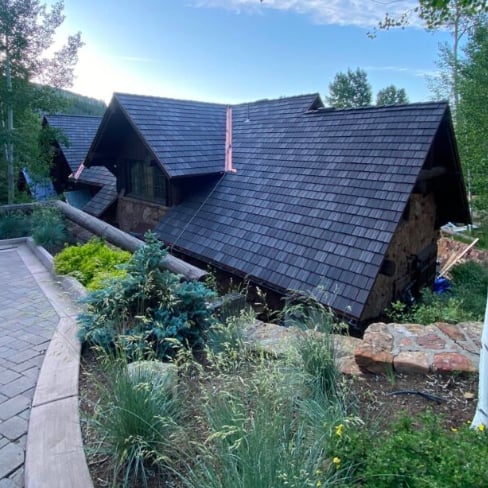
F-Wave Synthetic Shingle
F-Wave synthetic shingles are designed to mimic the look of real slate tiles. Not only do F-Wave shingles provide a premium look that will set your roof apart from your neighbor's, but they are far more durable and lighter weight than real slate tiles. F-Wave shingles do not suffer the granular loss like asphalt shingles because F-Wave shingles do not have granules.
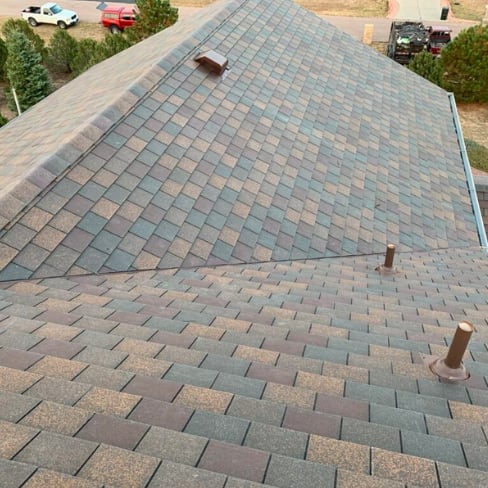
Stone-Coated Steel
Stone-coated steel is a more decorative roofing solution than dimensional or even designer shingles. Stone-coated steel roofing panels come in several different styles that are made to mimic the look of other roofing systems, like shake and tile roofs. The main advantage of this system is that if installed with 2″x2″ battens beneath the roofing panels, the system allows any water that may find its way under the panels to drain out without causing damage to your decking. While this installation method does provide a very clean look, the price associated with it is similar to what synthetic shingles cost.
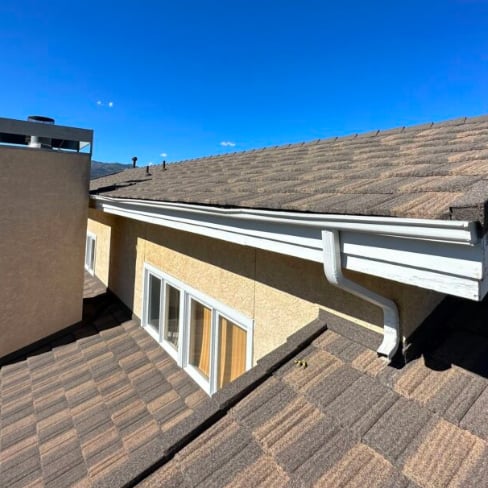
How much does a new roof cost?
When you need a new roof, it can be difficult to find concrete answers on how much it will actually cost you. This section lays out the factors that go into calculating the cost of your roof and help to answer any questions that you may have about your roof.

What is the cost to replace your Roof?
As a general rule of thumb, if you own a typical single-family home in Colorado Springs, you can expect a new roof to cost between $14,000 - $20,000. This ballpark figure is based on an architectural shingle asphalt roofing system on a 2,400 sq ft home with a walkable roof pitch and little roof complexity.
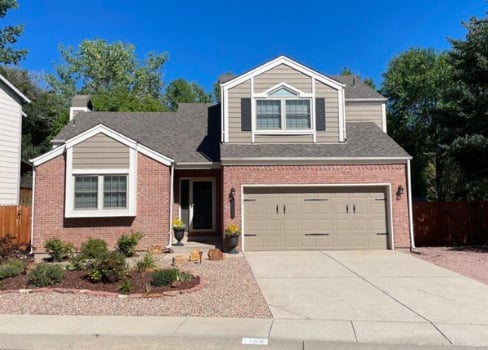
Variables That Affect the Cost of Your New Roof
Roof Size: One of the biggest determinants of how much your roof will cost.
Roof Style: More complex or cut-up roofs will come with a higher price.
Material Choice: Roofing materials come in “good, better, and best” options with steadily increasing prices to go along with each.
Labor: Labor costs depend highly on the type of material, roof type, and location.
Miscellaneous Costs: Permit fees, inspections, port-a-potties, warranties, material deliveries, etc..
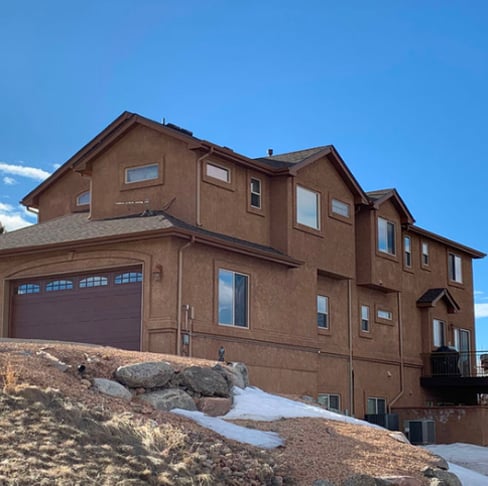
Financing Your New Roof
While paying for a new roof is expensive, it’s a necessary investment when your roof needs replacement due to damage or old age. Financing costs is a great option when faced with a roof replacement expense. This section will cover the two simple ways to finance your roof and protect your home.
Worried About Paying for Your New Roof?
What you may be thinking:
- I need a new roof, but I can’t afford it now.
- Is there a way I can finance a new roof?
- I know that my roof has damage, but I’m waiting for bad weather to replace it, so my insurance policy will cover it.
- It’s hard to get reasonable financing rates to replace a roof.
Two main ways to finance your new roof:
- Finance through your roofing contractor.
- Open a Home Equity Line of Credit (HELOC).

Financing Through Your Contractor
Most roofing contractors offer private financing. Most often, the financing is secured through a third-party financing program, but some companies offer in-house financing. If you decide to finance your roof through your contractor, here are the three steps you can expect to take:
Step 1: Select a reputable roofer that offers financing:
Before any roof work on your house can begin, choosing a good roofing contractor is important. If you know you want to secure financing through your contractor, you must ensure that the roofer you select offers financing.
Step 2: Apply for a roof loan through your contractor:
Your contractor should be able to walk you through each step. The application process will be done with the contractor’s direct help in their office, or they may send you an information packet that outlines the application process. More often than not, your contractor will have some part in the financing process.
Step 3: Get approved and get your project completed:
Once approved for financing and work has been completed, your finance company will release the funds to pay your roofing contractor. With your contractor compensated for their work, the relationship between your finance company and contractor ends. Instead of paying your contractor, you will pay your financing company installments over time, similar to a car or student loan.
Note: If you are interested in the financing process to pay for your roof, you should let your contractor know that financing is your intended path. Armed with this information, your contractor can create financing plans.

Home Equity Line of Credit (HELOC)
A home equity line of credit (HELOC) is a line of credit secured by your home that gives you a revolving credit line to use for significant expenses. The information below regarding a HELOC is for informational purposes only, and we advise you to speak with experts if you would like to look into this.
Step 1: Do Some Online Research
Spend some time researching what a HELOC is and how it works. Talk to your friends and neighbors to see if they have used a HELOC before and their experience. Next, if you have a mortgage on your home, speak with your mortgage company about options.
Step 2: Find a Lender
It is important to understand how interest rates and terms work. You want to find the loan that you are comfortable with. Most rates are floating, so be aware that the rate may change during the course of the loan.
Step 3: Get an Appraisal
More often than not, your lender will do the appraisal for you. However, if they will not, you will need to get your home appraised by a real estate appraiser. To begin with, you can look up your address on a site like Zillow to get a quick estimate of what your home is worth.
Step 4: Approval
After you are approved for your HELOC, you can borrow money against your HELOC for home improvements such as a roof.
Financing - Things you should know
By using a financing company, you are entering into an agreement with your roofing contractor to ensure that they are paid for their work and the financing company to repay them the amount borrowed for your new roof.
It is essential to understand you will end up paying more by choosing to finance your roof.
Interest is attached to financing your roof, like buying a car or paying student loans, which means that over the lifetime of your roof, you will be paying the principal amount plus interest. The amount of interest will depend on several factors, including how much you were approved for financing, your repayment term, and your credit and loan history. Any of these factors can affect your interest rate.
Remember, this is a significant investment that protects all the contents in your home. Sometimes the best choice isn’t always the least expensive.
Warranties on Your New roof
Roofing Material Warranties
Material warranties come from the manufacturer of your roofing materials. All roof material products come with a standard material defect warranty that protects you from defects in the material. Defects include wind damage (only if winds are less than the shingle's rating), granular loss, and blistering.
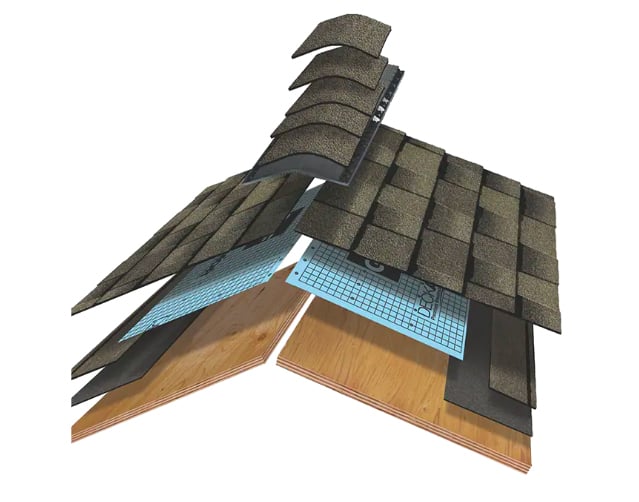
Workmanship Warranty
Every roofing contractor should offer a workmanship warranty on their work. A workmanship warranty covers you from installation errors that lead to leaks or issues. For example, if a shingle is installed incorrectly and causes leaks, a roofing contractor will fix this issue for no cost if it is within the timeframe covered by the workmanship warranty. All roofing contractors may offer different length workmanship warranties. We have seen roofing contractors offer workmanship warranties ranging from 1 to 25 years in our Colorado Springs community. Please be careful, though. Workmanship warranties are only as good as the paper they're written on. If the contractor is out of business, the warranty isn’t worth anything; which is why you should always hire a reputable roofing contractor.
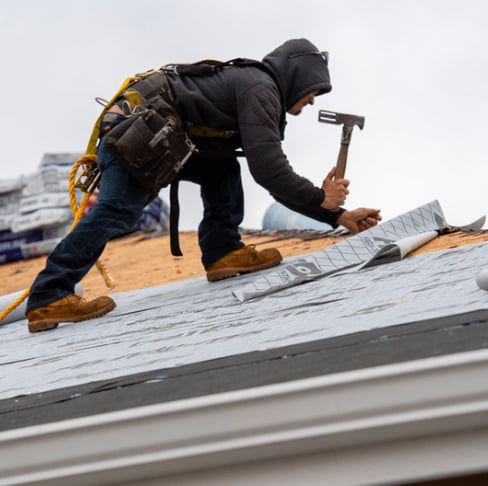
Extended Warranties
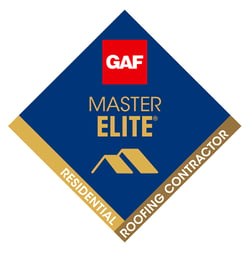 Roofing contractors that are “certified” with a manufacturer are able to offer extended warranties through the manufacturer. Extended warranties often include both material and workmanship warranties bundled into one extended warranty. They require that the majority of the products on your roof come from the same manufacturer and can also be known as a “System” warranty. This means the entire roofing system is under warranty, rather than the individual products on the roof. Extended warranties cover your entire roofing system if one or more of the components on your roof fails.
Roofing contractors that are “certified” with a manufacturer are able to offer extended warranties through the manufacturer. Extended warranties often include both material and workmanship warranties bundled into one extended warranty. They require that the majority of the products on your roof come from the same manufacturer and can also be known as a “System” warranty. This means the entire roofing system is under warranty, rather than the individual products on the roof. Extended warranties cover your entire roofing system if one or more of the components on your roof fails.
Extended warranties come with a cost, and your contractor will most likely pass the warranty cost along to you.
When you register an extended warranty with a manufacturer, you’ll get a non-prorated warranty that includes labor and materials. There are different levels of extended warranties, so ask your roofing contractor about the options to learn which level makes the most sense. Each manufacturer has slightly different details included or excluded in their extended warranty options.
Be sure to verify that your contractor is listed on the manufacturer’s website if your contractor is offering you extended warranties.
Finding a Qualified Roofing Contractor
Finding the right roofing contractor can be a process, but if you focus on asking a few key questions, you will be able to find the right roofer for your home and feel confident with your decision.
When comparing roofers, there are several questions you can research on each company to help you find the right contractor.
These include:
- How long has the company been in business?
- Local vs. Out of Town
- Size of Company/Crews
- Reviews and Testimonials
- Manufacturer Certifications and Warranties
- Website and Online Presence
- Transparent Pricing
- Experience with a specific type of roof or material
- Availability to start your project within your desired timeframe
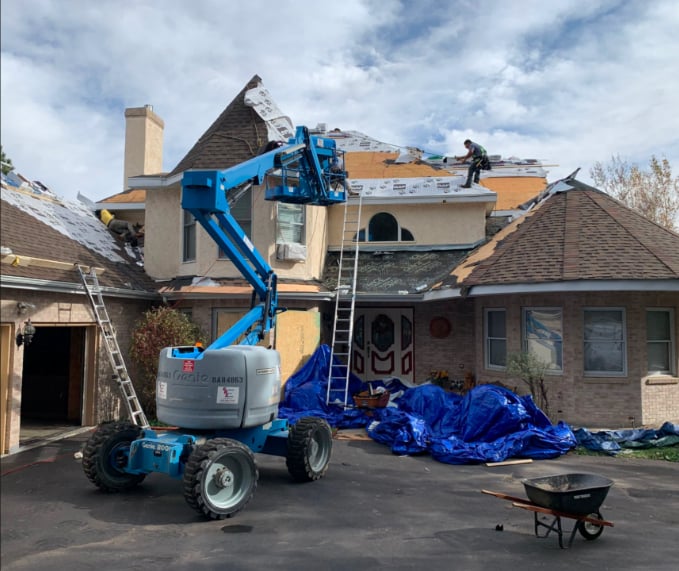
How Long Has the Company Been in Business?
An important factor to consider when comparing roofing contractors for your new roof is to look at how long the company has been in business. We think a company that’s 10 years old is a good minimum criteria. Companies that have been around for more than 10 year likely:
- Have completed a wide range of work and are more likely to be knowledgeable on a variety of different roofing solutions.
- Are well-versed in common roofing problems and solutions.
- Have multiple references from past customers to vouch for their work.
- Are more reliable in terms of sticking around for the long term and being able to fix problems that may arise down the road.
- Have likely experienced booms and busts in the industry and were able to be successful during both.
When considering a newer company, keep in mind that they:
- Are more likely to take on work that they have little to no experience with.
- May not be as stable as an older company, introducing risk for the future.
- May not have a deep track record for customer references.
Statistically, new roofing companies have a high failure rate; it’s not certain they will stay in business to guarantee warranties. In his book, Markup & Profit: A Contractor's Guide, Michael C. Stone writes that within the first year of business, 30% of all new construction-related businesses fail. He says between 90 to 96 percent fail within a 10-year business cycle.
The biggest risk of choosing a new company is the failure rate. You want to choose a roofing company with a proven track record and will be around for years to come to service your roof’s warranty.
Local vs. Not Local
Another factor to consider is whether a roofing contractor is locally owned and operated. We strongly encourage you to prioritize local companies for several reasons.
A local roofing company is likely to:
- Be more responsive and available to fix issues if they arise, simply because they are located in your city.
- Be a short drive away from your home and can tend to your issue much faster than a company located hours away. Weather issues can cause roofing issues, and a local company can make it to your home much faster.
- Be familiar with local building codes and any code changes, making sure your roof work gets done more quickly, with fewer roadblocks.
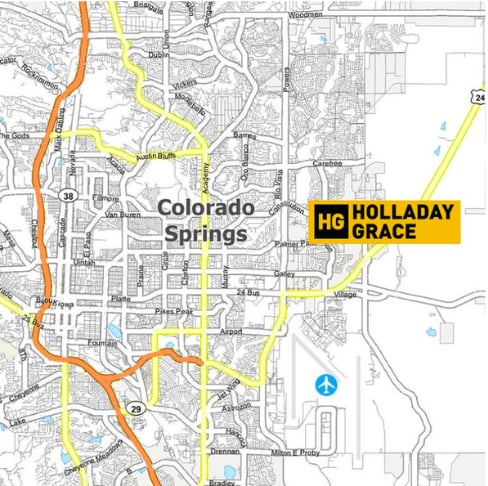
Company/Crew Size & Employee Caliber
Size Of Company and Crew
Company size is an important factor to consider when looking for a roofer. There are positives and negatives to working with both small and large companies. The size of a company can affect employee caliber, customer service, and crew size. Smaller companies tend to have smaller crew sizes. Depending on your goals, you may be okay with a smaller crew. This means the project may last a few days longer. When talking to roofing companies, ask how many workers are in each crew and how many people will be working on your roof. Larger companies may have larger crew sizes.
Employee Caliber
Smaller companies usually have fewer employees, which can be good during a project. Small companies have fewer employees that may provide higher quality of work. However, in times of heavy workloads, the work may pile up and create long lead times. Larger companies can employ a larger staff lead times so work can start much faster.
Customer Service
A good way to tell if you will get good customer service is to reach out to the company. How quickly do they respond? If an email or a phone call is answered in a timely and friendly manner, that’s a good sign that the company is customer service-focused. If you call the company and cannot speak to someone in the office or keep getting routed to automated systems, this may be a red flag.

Customer Reviews
When Reading Reviews, Pay Attention To The Good AND Bad Reviews:
You will always find good and bad reviews regardless of how well or poorly the company did. Some people may have had excellent experiences with bad companies and poor experiences with good companies. The key is to weed out those outlier reviews and narrow down the ones that matter. Focus on genuine reviews by customers who had work completed when doing your research. Be wary of reviews that are oddly similar in their vocabulary; chances are those reviews are not genuine and should not be taken into account when deciding which contractor to choose. Also, pay attention to if the roofing company responds to reviews. A responsive company will likely be strong on customer service.
Testimonials Are A Good Research Tool
Talking to friends and neighbors about their roofing contractor experiences will help you narrow your decision. If a neighbor or friend has recently had or is having their roof done, get their opinion on the company. Ask about the quality of work, project organization, site cleanliness, customer service, and value. Make sure their answers align with your expectations.
Manufacturer Certifications and Warranties
Manufacturers' warranties and certifications are important! Certifications vary by the contractor and often determine the warranty that you, as the roof owner, are eligible for from the material manufacturer.
Additionally, companies with more certifications with manufacturers often have close relationships with their local manufacturer sales representatives, enabling better pricing than less certified companies. Additionally, if anything were to happen to your roof, companies with good relationships with their sales reps would be able to get the materials they need to fix roofs faster.
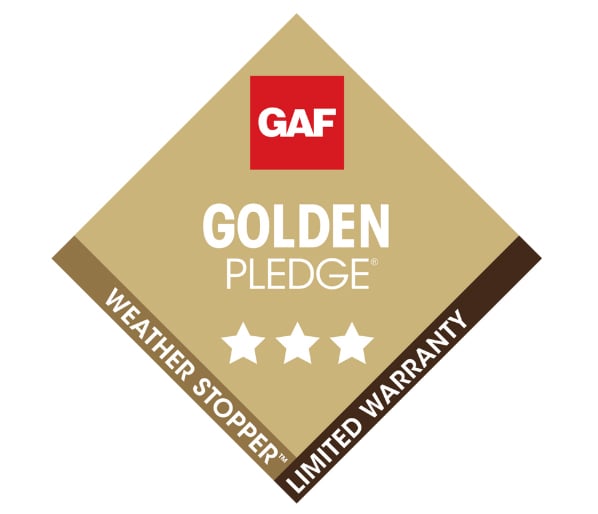
Transparent Pricing
To avoid any last-minute cost surprises, you’ll want to select a company with transparent pricing policies. You want to understand exactly what you are paying for. Ensure your contractor is up-front about all the project's costs, including material, labor, fees, permits, and any miscellaneous costs associated with your project.
Additionally, you will want to understand how your contractor will handle change orders. Sometimes when roofs are torn off, decking or other items beneath the roof system are rotted, not up to code, and must be replaced. Ask your contractor about their change order process.
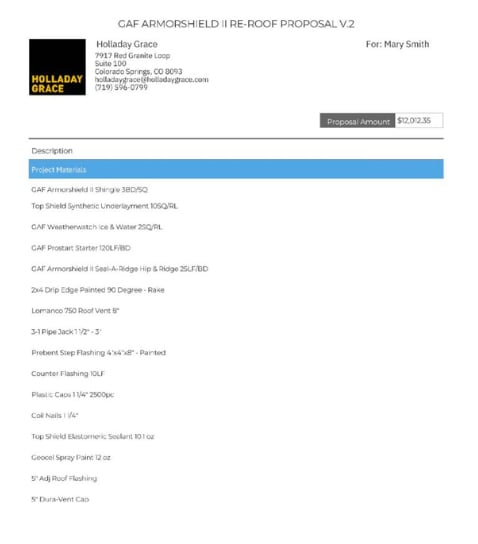
Experience
You will want to choose a contractor that has experience with jobs similar to yours. If you have a complex, high, steep roof, you want to ensure the contractor you choose has successfully completed similar jobs.
Also, you'll want to verify that your roofer has experience installing the material you choose. Explore the contractor's website and online reviews to learn if they have experience with your type of roof and material.
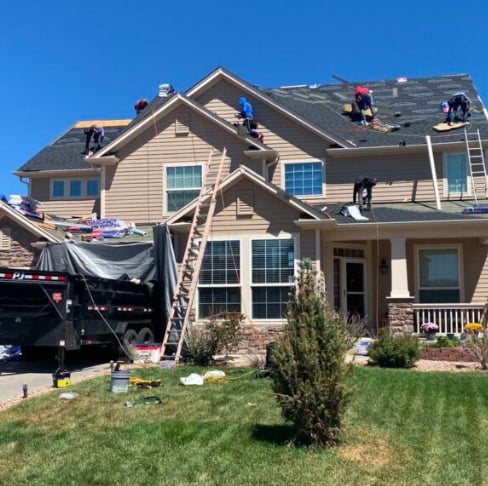
Availability
When calling contractors, make sure they have availability to complete your project within your desired timeframe. Remember that roofing contractors are typically busier in the summer, but re-roofs can be completed any time of year as long as the temperature is 40 degrees and rising. Generally, Holladay Grace can re-roof any time of year.

Getting an Estimate from Holladay Grace
Now that you've gone through this guide, you’re ready to purchase your new roof. Using the tips from this guide, you’re ready to find a great roofing contractor.
But if you’re local to the Colorado Springs area, we’re pleased to serve you and your roofing needs.
Check out the simple 4-step process of getting an estimate from our team.
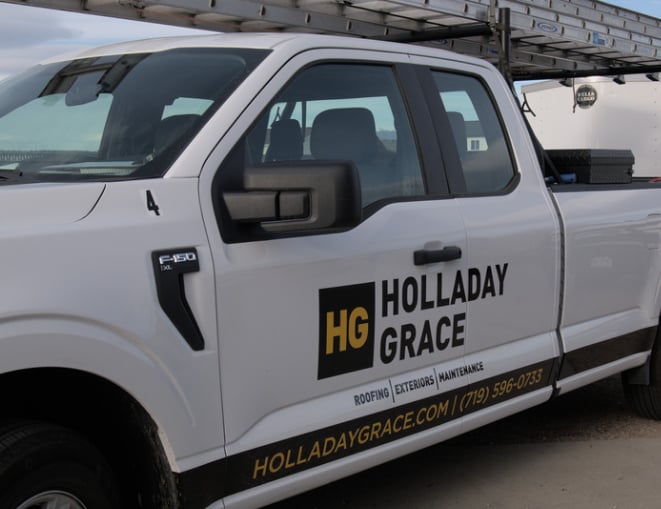
Step 1 - Contact us
Whether you speak to one of our team members or fill out a request form online, be sure to clearly explain the problem you are having. The more detailed the request, the easier it is for us to understand what is going on and how we can fix it. Be sure to give us a good phone number we can reach you at. Sometimes discussing the problem on the phone is easier than trying to put it in writing.
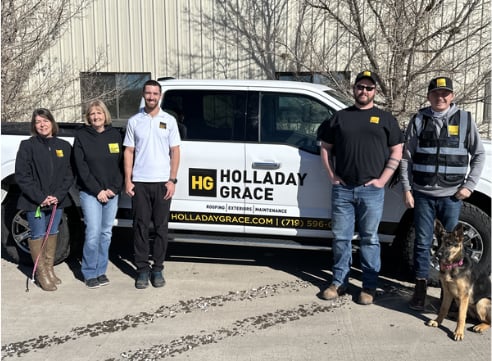
Step 2 - Schedule Your Inspection
Once we have your information, we will contact you to schedule an inspection. It is not necessary for you to be home for the roof inspection, but it may be beneficial if you or the inspector have any questions. One benefit of being home is that our inspector can access your attic to inspect either the trusses or decking of your house to provide an estimate for work more accurately.
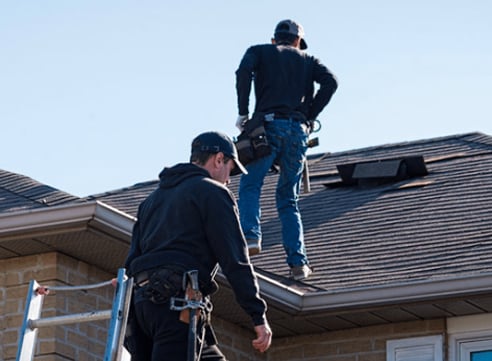
Step 3 - Receive Your Estimate
If we find anything that warrants work during our inspection, you will receive an estimate. The estimate will outline what was found during the inspection, and we will provide a price to fix the issues. Often, we are able to simply repair areas of the roof. Proactively repairing your roof will prolong the life of your roof. Please note, there are cases when we find roofs that need to be replaced. We will be sure to clarify whether you need a repair or a replacement. The estimate will either be hand delivered or emailed to you.

Step 4 - Weigh Your Options
With your estimate in hand, you can now go over the document. If you received your estimate via email, you are able to accept and sign your estimate electronically. Once you have electronically signed the estimate, our system will let us know that you have done so. Please note that we have customers that do not have an email address and are unable to do this. We have been in business since 1979 and have hand-delivered countless estimates as well as picked up signed contracts.

What You'll Find in Your proposal
To avoid any surprises, your roof estimate from Holladay Grace is comprehensive and will include the following:
- Type of Roofing Covering
- Type of Underlayment
- Type of Starter Shingle
- Hip and Ridge Shingles
- The type of hip and ridge used should be a compatible product line and the same manufacturer as the roof covering you choose.
- 2″x4″ Drip Edge (often called Edge Metal)
- 120-degree angle for eaves
- 90-degree angle for the rake
- Roof Vents
- The type and size that is currently installed will often determine what is replaced.
- Please note that many older homes are under-ventilated, and we may recommend increasing your roof’s ventilation to meet manufacturer recommendations and specifications.
- Pipe Jacks
- Step Flashing
- Used at sidewall transitions to shed water off the roof and to help prevent moisture from getting behind siding or stucco.
- Counter Flashing
- Placed at any roof-to-wall transition and sealed with elastomeric sealant as an added layer of moisture protection.
- Plastic Cap Nails
- Used to attach the synthetic underlayment to your roof decking. Typically 1 ¼″ in length.
- Coil Nails
- Used for attaching asphalt shingles to the roof deck.
- Sealant
- Used for sealing around any seams or penetrations.
- Spray Paint
- It will be a color that matches your chosen roofing system.
- Decking (if needed)
- Your roof may be in need of new decking if the existing decking is damaged or not up to code.
- Labor
- Labor costs for a full re-roof will always include removing and replacing shingles. Labor will also include laying synthetic felt underlayment and replacing or installing flashing at walls or chimneys. If any decking needs to be replaced, this is where it will be notated.
- Miscellaneous Items. This section will contain the permit fees, delivery fees, and the type of warranty offered on your roof.
Inspection Report Example
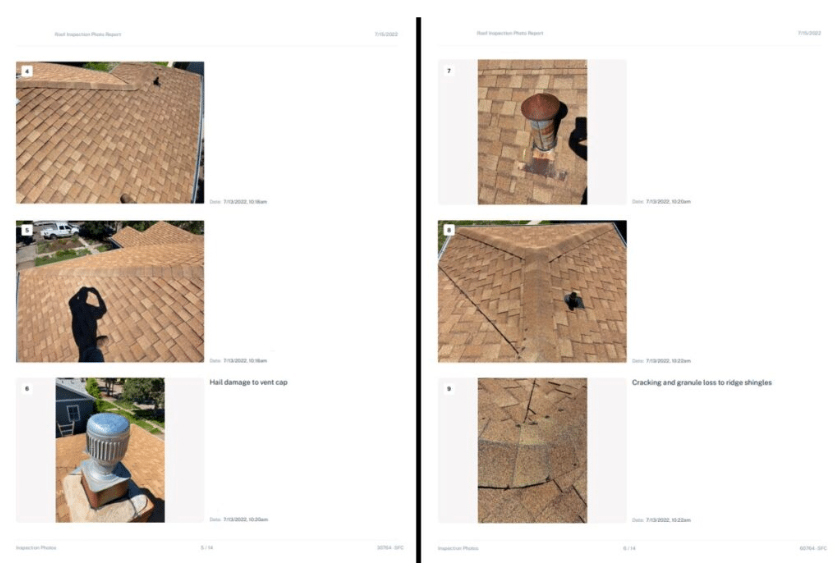
Congratulations You Made It to the End!
You’re at the end of The Homeowners Guide to Buying a Roof. Now that you've finished, you’re now one of the most informed homeowners in the roofing industry!
If you’re local to Colorado Springs, don’t hesitate to Contact Us or call 719-596-0733 for any of your roof replacement needs.
If you aren’t local or don’t think we’re the right fit, go shock the roofing industry with the knowledge you got from this guide!
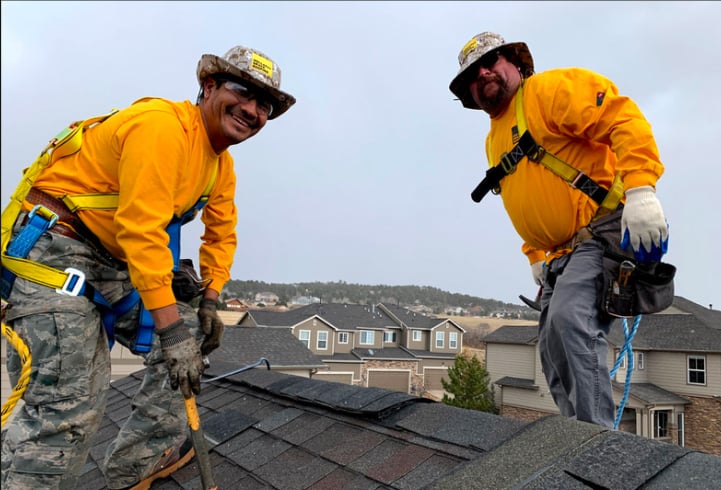
SCHEDULE YOUR INSPECTION TODAY
Whether you have a planned roof replacement or fell victim to Colorado’s ever-changing weather, Holladay Grace will find the right roofing system to meet your needs.
Ready to replace your roof or curious about your roof’s condition? Holladay Grace provides free roof consultations and inspections to identify any problems or simply give you peace of mind. Fill out the inquiry form or call us today.
